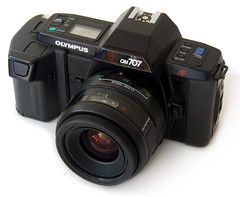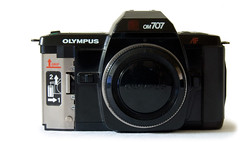Rebollo fr (talk | contribs) m (cat) |
Timmy Toucan (talk | contribs) mNo edit summary |
||
| Line 1: | Line 1: | ||
| − | <div class="floatright">[http://www.flickr.com/photos/timmythesuk/ |
+ | <div class="floatright">[http://www.flickr.com/photos/timmythesuk/318225561/in/pool-camerapedia/ http://static.flickr.com/125/318225561_eb5343754d_m.jpg]</div> |
<div class="floatright">[http://www.flickr.com/search/groups/?q=om%20707&w=46195334%40N00&m=pool Other Images]</div> |
<div class="floatright">[http://www.flickr.com/search/groups/?q=om%20707&w=46195334%40N00&m=pool Other Images]</div> |
||
The Olympus '''OM-707''' was released by [[Olympus]] in 1986, and was their first attempt to make a fully autofocus SLR body. On some markets, it was called '''OM-77'''. |
The Olympus '''OM-707''' was released by [[Olympus]] in 1986, and was their first attempt to make a fully autofocus SLR body. On some markets, it was called '''OM-77'''. |
||
Revision as of 07:41, 10 December 2006
The Olympus OM-707 was released by Olympus in 1986, and was their first attempt to make a fully autofocus SLR body. On some markets, it was called OM-77.
In 1985 the Minolta 7000 had shown the way to a usable AF SLR, after various unsuccessful attempts like the Pentax ME-F, the Olympus OM-30, the Canon T-80 and the more serious Nikon F3AF. The other makers would follow, with the Nikon F-501, the Canon EOS 650, the Olympus OM-707 and the Pentax SF-X. The OM-707 was the least successful of all. It maintained the OM bayonet mount and could mount all the Olympus OM lenses, but the new lenses specially designed for the autofocus did not have any manual focusing ring. This was not acceptable because the first autofocus systems weren't very accurate or sensitive and there were many cases when manual override was necessary; Olympus' solution to this was to include a 'Power Focus' feature whereby a sliding 'shift knob' on the rear of the camera controls the focus. This is relatively accurate, though does not offer the same precision or speed as a manually focused lens offers. This feature actually outlived Olympus' OM autofocus to reappear on the OM-101 which was Power Focus only. The OM-707 generally lacked all the features of a top range camera, and was aimed at the middle range market, like the OM-10.
The OM-707 also dropped compatibility with nearly all the accessories that made so much for the success of the OM system. There was one OM System accessory released specifically for this camera however: its partner the F280 Full-Synchro stroboscopic flash, syncing with this up to 1/2000 of a second. This flash/camera combination was reportedly the first in the world to offer such high speed syncing. The F280 also features a high-power AF illuminator lamp to aid low light focussing.
Another 'accessory' released for the OM-707 was the option of two grips with which to hold the camera. The Power Flash Grip 300 is powered by 4x AAA batteries and features a built-in pop-up flash; the alternative Power Grip 100 is again powered by 4x AAA, features no flash, but is far less bulky to operate. Both grips feature the shutter release switch: without a grip attached the camera is unusable and un-powered.
The market failure of the OM-707 led Olympus to take the problem in another way. They made one last camera using the autofocus/powerfocus lenses, the OM-101 and then began to develop the IS series bridge cameras. Today Olympus continues this strategy of producing cameras somewhat different from the other makers with the Four-Thirds and 'E' systems.
Specifications
- Shutter: Electronically controlled vertical-travel focal-plane shutter. Shutter speed: 2-1/2000 sec
- Lens Mount: Olympus OM for AF lenses (accepts OM manual and OM-AF lenses)
- Exposure Control: TTL 'OTF' centre-weighted
- Exposure Mode: Program; Program shift (with shift knob); Aperture preferred with OM manual lenses
- AE lock; AF lock
- Flash Control: Full synchro with F280; TTL 'flashmatic' sync up to 1/100 with PowerGrip 300; TTL direct 'OTF' with T-series flashes
- Viewfinder: 93% of field fixed screen with marked autofocus zone
- Auto film loading; auto film advance (1.5 fps); auto film rewind
- 12 second self-timer
- Weight: 555g without lens/grip/batteries
- Built-in AF Illuminator lamp
Links
- 'The Unofficial Olympus Sales Information File' page about the OM-707
- Olympus OM-77AF manual (.pdf) from olympus.com
In Japanese:
| Olympus Classic Cameras |
|---|
| Semi | Semi II | Six | Chrome Six | Flex | Standard | 35 | Ace | Pen | Pen F | FTL | OM-1/2/3/4 | OM-10/20/30/40 | OM-707 | OM-101 | XA |

